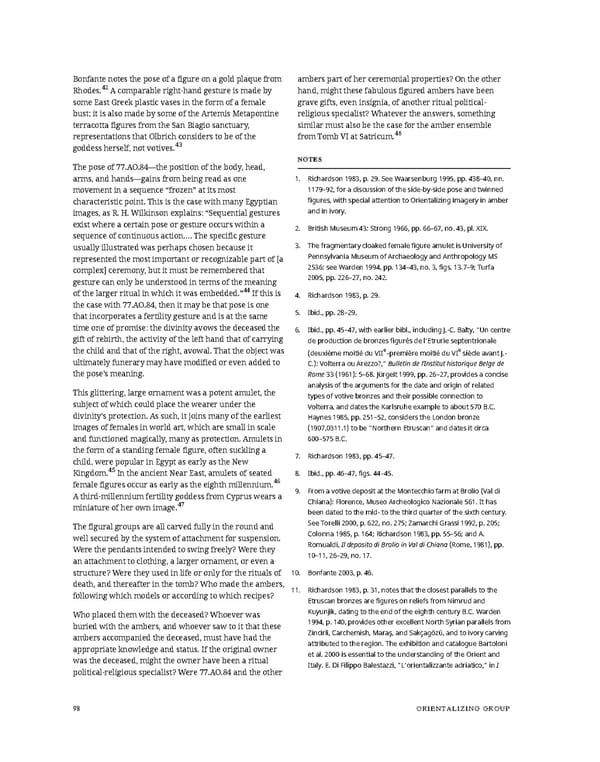Bonfante notes the pose of a figure on a gold plaque from ambers part of her ceremonial properties? On the other Rhodes.42 A comparable right-hand gesture is made by hand, might these fabulous figured ambers have been some East Greek plastic vases in the form of a female grave gifts, even insignia, of another ritual political- bust; it is also made by some of the Artemis Metapontine religious specialist? Whatever the answers, something terracotta figures from the San Biagio sanctuary, similar must also be the case for the amber ensemble representations that Olbrich considers to be of the from Tomb VI at Satricum.48 goddess herself, not votives.43 NOTES The pose of 77.AO.84—the position of the body, head, arms, and hands—gains from being read as one 1. Richardson 1983, p. 29. See Waarsenburg 1995, pp. 438–40, nn. movement in a sequence “frozen” at its most 1179–92, for a discussion of the side-by-side pose and twinned characteristic point. This is the case with many Egyptian figures, with special attention to Orientalizing imagery in amber images, as R. H. Wilkinson explains: “Sequential gestures and in ivory. exist where a certain pose or gesture occurs within a 2. British Museum 43: Strong 1966, pp. 66–67, no. 43, pl. XIX. sequence of continuous action.… The specific gesture usually illustrated was perhaps chosen because it 3. The fragmentary cloaked female figure amulet is University of represented the most important or recognizable part of [a Pennsylvania Museum of Archaeology and Anthropology MS complex] ceremony, but it must be remembered that 2536: see Warden 1994, pp. 134–43, no. 3, figs. 13.7–9; Turfa gesture can only be understood in terms of the meaning 2005, pp. 226–27, no. 242. of the larger ritual in which it was embedded.”44 If this is 4. Richardson 1983, p. 29. the case with 77.AO.84, then it may be that pose is one that incorporates a fertility gesture and is at the same 5. Ibid., pp. 28–29. time one of promise: the divinity avows the deceased the 6. Ibid., pp. 45–47, with earlier bibl., including J.-C. Balty, “Un centre gift of rebirth, the activity of the left hand that of carrying de production de bronzes figurés de l’Etrurie septentrionale the child and that of the right, avowal. That the object was (deuxième moitié du VIIe–première moitié du VIe siècle avant J.- ultimately funerary may have modified or even added to C.): Volterra ou Arezzo?,” Bulletin de l’Institut historique Belge de the pose’s meaning. Rome33 (1961): 5–68. Jürgeit 1999, pp. 26–27, provides a concise This glittering, large ornament was a potent amulet, the analysis of the arguments for the date and origin of related types of votive bronzes and their possible connection to subject of which could place the wearer under the Volterra, and dates the Karlsruhe example to about 570 B.C. divinity’s protection. As such, it joins many of the earliest Haynes 1985, pp. 251–52, considers the London bronze images of females in world art, which are small in scale (1907,0311.1) to be “Northern Etruscan” and dates it circa and functioned magically, many as protection. Amulets in 600–575 B.C. the form of a standing female figure, often suckling a 7. Richardson 1983, pp. 45–47. child, were popular in Egypt as early as the New Kingdom.45In the ancient Near East, amulets of seated 8. Ibid., pp. 46–47, figs. 44–45. female figures occur as early as the eighth millennium.46 A third-millennium fertility goddess from Cyprus wears a 9. From a votive deposit at the Montecchio farm at Brolio (Val di miniature of her own image.47 Chiana): Florence, Museo Archeologico Nazionale 561. It has been dated to the mid- to the third quarter of the sixth century. The figural groups are all carved fully in the round and SeeTorelli 2000, p. 622, no. 275; Zamarchi Grassi 1992, p. 205; well secured by the system of attachment for suspension. Colonna 1985, p. 164; Richardson 1983, pp. 55–56; and A. Were the pendants intended to swing freely? Were they Romualdi, Il deposito di Brolio in Val di Chiana (Rome, 1981), pp. an attachment to clothing, a larger ornament, or even a 10–11, 26–29, no. 17. structure? Were they used in life or only for the rituals of 10. Bonfante 2003, p. 46. death, and thereafter in the tomb? Who made the ambers, 11. Richardson 1983, p. 31, notes that the closest parallels to the following which models or according to which recipes? Etruscan bronzes are figures on reliefs from Nimrud and Who placed them with the deceased? Whoever was Kuyunjik, dating to the end of the eighth century B.C. Warden buried with the ambers, and whoever saw to it that these 1994, p. 140, provides other excellent North Syrian parallels from ambers accompanied the deceased, must have had the Zincirli, Carchemish, Maraş, and Sakçagözü, and to ivory carving appropriate knowledge and status. If the original owner attributed to the region. The exhibition and catalogue Bartoloni was the deceased, might the owner have been a ritual et al. 2000 is essential to the understanding of the Orient and political-religious specialist? Were 77.AO.84 and the other Italy. E. Di Filippo Balestazzi, “L’orientalizzante adriatico,” in I 98 ORIENTALIZING GROUP
 Ancient Carved Ambers in the J. Paul Getty Museum Page 107 Page 109
Ancient Carved Ambers in the J. Paul Getty Museum Page 107 Page 109